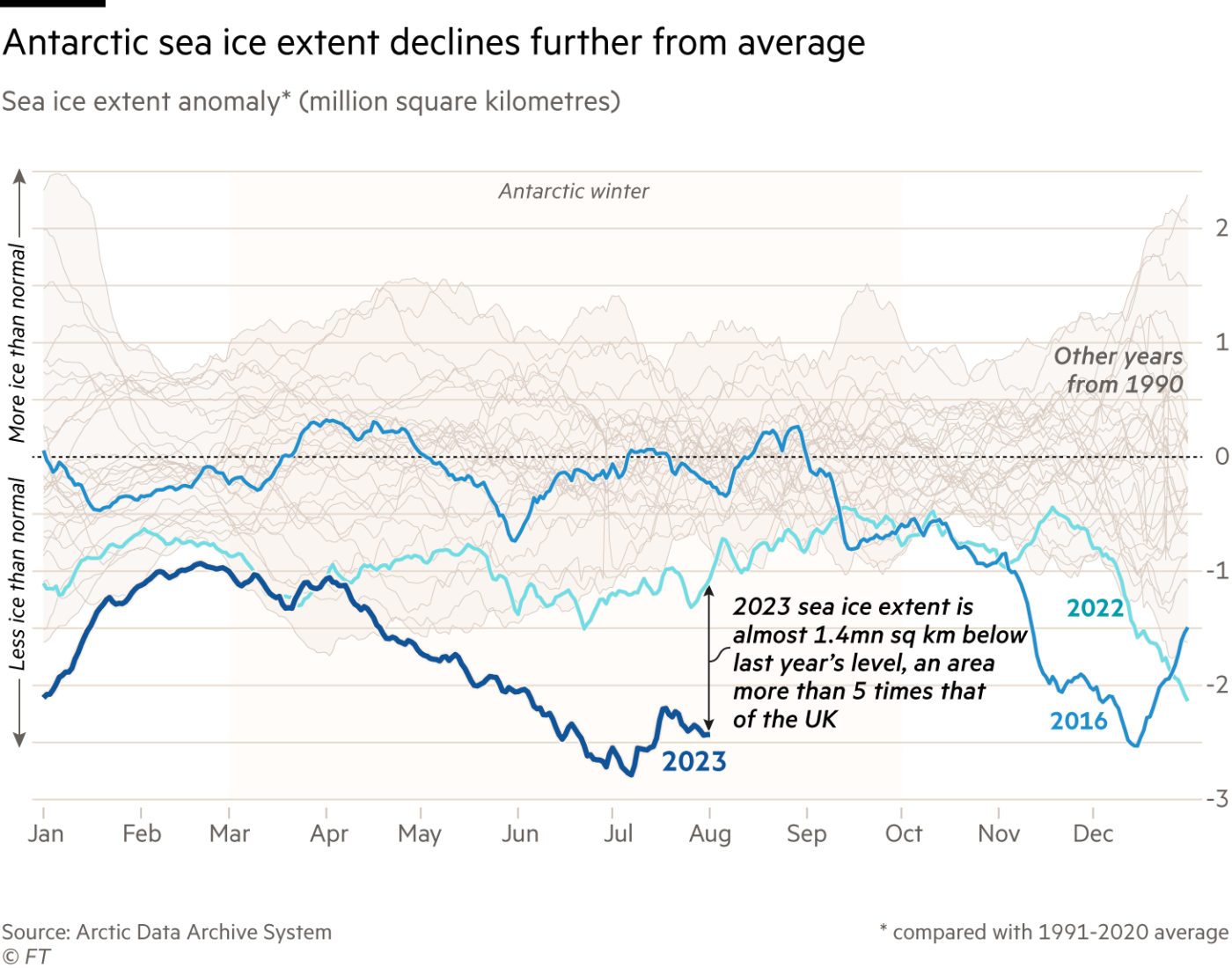
Over the past few weeks, a large-scale rescue operation has been under way off the coast and keys of Florida. It began as water temperatures were rising towards a peak of 38.4˚C — similar to someone with a high fever — which was recorded on July 24 by a buoy off Manatee Bay.
The coral crisis in Florida and the Caribbean is just one of the ways in which the oceans have shocked and alarmed scientists this year. Perhaps the most striking evidence has been in the seas around Antarctica, where far less ice than usual is forming in the annual midwinter freeze.
Marine biologists are worried too about the effect on fisheries of sea temperatures as much as 5˚C above normal in parts of the north Atlantic. “This really is an extremely unusual year,” says Stefan Rahmstorf, professor of ocean physics at Potsdam University in Germany. “If you look at Atlantic temperatures and Antarctic sea ice, the changes are off the charts.”
On August 1, average global sea surface temperatures reached an all-time high just short of 21˚C, Europe’s Copernicus Climate Change Service says. This record is particularly disconcerting because March is usually the hottest month for the world’s oceans.
In the depth of the southern winter, the ocean around Antarctica is freezing over. But this year sea ice is forming in slow motion, falling far short of any previous winter on record and leaving scientists shocked and mystified by the extent of still-open water. “What we’re seeing is truly remarkable,” says Ella Gilbert, a polar climate researcher at the British Antarctic Survey (BAS). “The missing ice has left an area of open ocean bigger than Greenland.”
Statisticians often try to measure how unusual an event is by the Greek letter sigma, which denotes its deviation from the mean. The missing Antarctic ice has reached seven sigma, judged from the baseline of the past 40 years, says Edward Doddridge, an oceanographer at the Institute for Marine and Antarctic Studies in Tasmania. That means it would not occur by chance in many billions of years. “What it really tells us is that the statistical model has failed,” he says. “We are so far outside the historical range that it no longer makes sense to talk about sigma and standard deviations. This must be a new state of the system, fundamentally unlike previous years.”
Over several decades up to 2015, the extent of Antarctic sea ice increased slightly, in contrast with declining Arctic ice cover — and contrary to the predictions of scientific modelling which shows less glaciation for both polar oceans in response to global warming. The expected decrease started in 2016 and gathered pace before this year’s precipitous fall.
The effects on wildlife and ecosystems will be many and varied. Mammals and birds that rely on sea ice to feed or breed, such as emperor penguins, will be hit hard. But ecologists are most worried about how krill will cope. These tiny crustaceans, which populate the polar oceans in vast numbers, “are basically the staple food source of everything around Antarctica,” says Doddridge. “Krill come up as larvae under the ice during the winter and they feed on algae growing on the underside of the ice,” he says. “If that ice disappears and the algae aren’t present, we don’t know what the krill will do because we’ve never seen them do anything else.”
Looking further ahead, climate scientists are concerned about the impact of melting ice around both polar regions on the great “overturning” circulations, the network of currents that span the world’s oceans at various depths, carrying heat, chemicals and nutrients around the world. The flow of fresh water from melting ice disrupts the sinking of cold and salty water to the ocean depths, from where it moves towards the tropics. There is evidence that both Antarctic and Atlantic overturning circulations are weakening as a result, with some experts suggesting that one or both might collapse at some point in the next few decades — with catastrophic effects on the world’s climate.
Heatwaves typically affect around 10% of the oceans at any one time. The proportion experiencing one is now 44%, according to the US National Oceanic and Atmospheric Administration. The agency forecasts that it will increase to 50% in September and October.